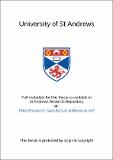Non-analytic shifts in smooth goal-directed human behaviour
Abstract
The thesis is aimed at finding the form of explanation and creating the associated computing methodology required to provide an effective computational explanation of smooth goal-directed behaviour. Smooth behaviour has typically been explained using analytic components. It is hypothesised that goal-directed smooth behaviour would benefit from a new hybrid form of explanation involving non-analytic as well as analytic aspects in order to account better for the type of plastic and persistent adaptation seen in natural agent behaviour. The thesis investigates strategies used by animate agents to control the shape of their motor actions in pursuing goals with a view to establishing their components. The hypothesis that there are non-analytic components in natural smooth goal-directed behaviour is empirically tested in the arena of human hand movement kinematics in a variety of experimental settings. The presence of these components in the behaviour is demonstrated in various ways involving the agent constantly redirecting itself so as to remain projecting non-analytically through the goal. The demonstrations begin with an investigation of a simplest base case of a behaviour that involves a smooth merge between two parallel linear movements. A further series of experiments generalizes the methodology to provide successful predictions for cases involving different ratios for the central movement, different directions at the ends of the movement, and with smooth external perturbations added to the movement. Computing and cognitive applications of the methodology are given. It is concluded that the new hybrid form of explanation and methodology is supported by the empirical evidence as being an appropriate one in many cases for providing an effective computational explanation of goal-directed smooth behaviour.
Type
Thesis, PhD Doctor of Philosopy
Collections
Items in the St Andrews Research Repository are protected by copyright, with all rights reserved, unless otherwise indicated.

